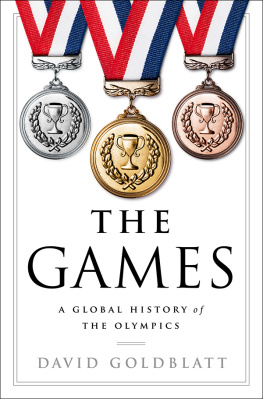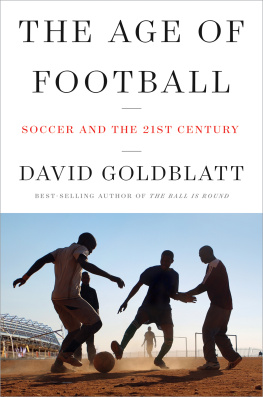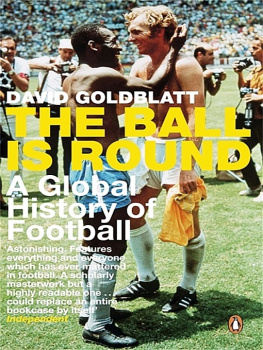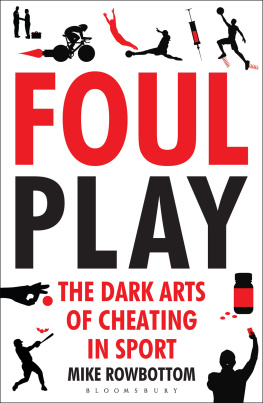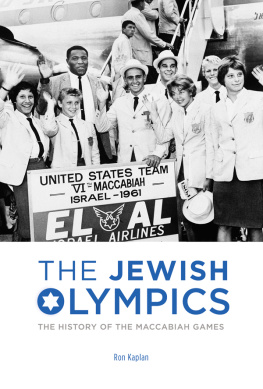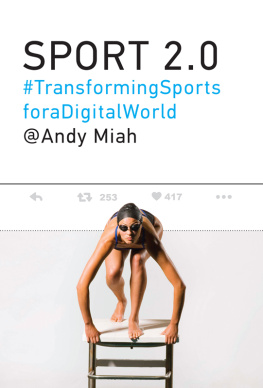THANKS
David and Johnny would like to thank: Sally for sealing the deal; Jonathan Surely Not?! Buckley for his unique style of editing, his inhuman fastidiousness and for saving us from ourselves; Henry Iles for his delightful layout; and our illustrator Belinda Evans for undergoing such a demanding crash course in the world of Olympic sport and drawing such nice stick people.
Special thanks for inspiration, amusement and diversion to, in no meaningful order: Lady Perce, Lady Sarah, Bunners, Mooers, Jefris More Bir Pakpahan, Lionel Richie, Paul Moss, and John from the Cock and Bottle pub. Last and most definitely not least, thanks, love and praise to the white-gloved impressario of the whole show, the incomparable Jeeves to our flustering Bertie Wooster, the one and only Mark Frasier Crane Ellingham. Bless them all.
HOW TO WATCH THE OLYMPICS
Scores and laws, heroes and zeros
an instant initiation into every sport
DAVID GOLDBLATT
and JOHNNY ACTON
Diagrams by Belinda Evans

First published in Great Britain in 2011 by
PROFILE BOOKS LTD
3A Exmouth House
Pine Street
London EC1R 0JH
www.profilebooks.com
Copyright David Goldblatt and Johnny Acton, 2011
10 9 8 7 6 5 4 3 2 1
Printed and bound in Great Britain by
Clays, Bungay, Suffolk
The moral right of the authors has been asserted.
All rights reserved. Without limiting the rights under copyright reserved above, no part of this publication may be reproduced, stored or introduced into a retrieval system, or transmitted, in any form or by any means (electronic, mechanical, photocopying, recording or otherwise), without the prior written permission of both the copyright owner and the publisher of this book.
The photo of Annette Kellerman on p.277 is copyright TopFoto. All other photographs in the book are copyright Getty Images..
A CIP catalogue record for this book is available from the British Library.
book ISBN 978 1 84668 475 3
e-book ISBN 978 184765 7589
CONTENTS
INTRODUCTION
For two and a half weeks every fourth summer, the planet reliably goes sports crazy. The most watched event in history wasnt the 1969 moon landing, the episode of Dallas which revealed who shot JR, or Charles and Dis wedding. It was the opening ceremony of the Beijing Summer Olympic Games. Over a billion people tuned in to at least part of the extravaganza. And 4.7 billion of us - around 70 per cent of the worlds population watched the sporting festival at some point over the next two and a half weeks.
In July 2012, we will all be at it again. Yet if were honest, theres a gaping hole at the heart of the Olympic experience: most of us know remarkably little about most of the sports weve suddenly gone nuts about. Of course, you could just plonk yourself down on a sofa and keep your eyes open. No harm in any of that, but to get the most out of the Olympics it really helps to know HOW TO WATCH the proceedings. Which is where this book comes in: a training programme for the Olympics, or, to be precise, a five-point-plan of crucial need-to-know information for each sport.
The first, overarching question is WHY WATCH any given sport? Why exactly do South Koreans turn out in their tens of thousands to watch the nations leading archers? Why do Turks venerate a 4ft-11in weightlifter? Are they all mad? Sometimes, the thrill is straightforward. Other times, you need to know the STORY OF A SPORT why it has mattered and to whom. Only then will you grasp why Denmark comes to a standstill during the womens handball or why it seems so terribly important to the Hungarians to beat the Russians in that water polo match.
Next, you need a grasp of the basics. To make sense of what is going on, you have to know the object of the exercise and understand the constraints the participants are operating under. How does one win, how does one lose, how does one score and how long will it all go on for? In other words, youve got to know the rules. Once youve cleared this hurdle, you are ready to take on board some of the FINER POINTS. This will enhance your enjoyment immeasurably. Understanding the different spins, for example, will improve your experience of table tennis no end. Appreciating the tactical stratagems of basketball will turn the blur of bodies into a sharply focused and thrilling encounter.
At this point, you will be in good enough shape to move on to the OLYMPIC HISTORY of the sport. This section provides historical context and introduces you to the legends, scandals and rivalries, showing how the sports trajectory at the Games has reflected and occasionally shaped our times.
Finally, there are some Olympic topics that are so interesting, controversial or otherwise important that they merit sections of their own. You will find the main text sprinkled with features devoted to everything from the history of drugs in weightlifting to the peculiar antics of the man who popularised recreational canoeing. Oh and theres a useful appendix at the end of the book listing the 26 PREVIOUS OLYMPIC GAMES, with details of their host cities, their key events... and, naturally, their mascots.
We hope you will treat this book as an amusing, knowledgeable and bizarrely passionate friend on hand to help you get the most out of the Games. We realise youre not an expert on the finer points of dressage; we wont laugh at you if you confuse a kayak with a canoe; and we know theres something faintly ridiculous about competitive walking, or a cycling race in which the competitors can sit still on their bikes for half an hour. But we have the greatest respect for what THE GAMES are about a cosmopolitan celebration of humanity, a demonstration of the universal power of sport and play, a showcase for the wonders of the human body and spirit and we want to help you to enjoy them.
David Goldblatt and Johnny Acton
PS: THE IOC
Olympic sports are littered with JARGON and ACRONYMS. You dont need to know the half of it to enjoy the sports, though where you do, youll find the low-down under each relevant section of this book. The one key acronym, which crops up in any discussion of the Olympics, is the IOC. This is the INTERNATIONAL OLYMPIC COMMITTEE, created by BARON PIERRE DE COUBERTIN in 1894 to oversee what we know as the modern Olympics . The IOC is made up of senior figures from international sports federations (Sepp Blatter from FIFA, for example), prominent former Olympians, and the great and the good (it helps to have a royal connection) . The IOC runs both the Summer and Winter Games, selects the host cities and approves the inclusion of new and existing sports (each of which are governed by their own international federations).
There are also 206 NATIONAL OLYMPIC COMMITTEES, which organise their countries teams and officials. Their number is rather more than the 193 states represented at the UN, as it includes such nations as Aruba, Guam and Cook Islands. Palestine is also recognised as an Olympic nation.

THE OPENING CEREMONY
JULY 2012
OLYMPIC STADIUM
Athletes: 12,000 (if they all show up)
OLYMPIC PRESENCE
THE 1896 GAMES OPENED WITH SPEECHES AND HYMNS. PARIS failed to put on an opening ceremony in 1900 and ST LOUIS wasnt much better in 1904. But since LONDON 1908 the ceremony has been a permanent fixture.


